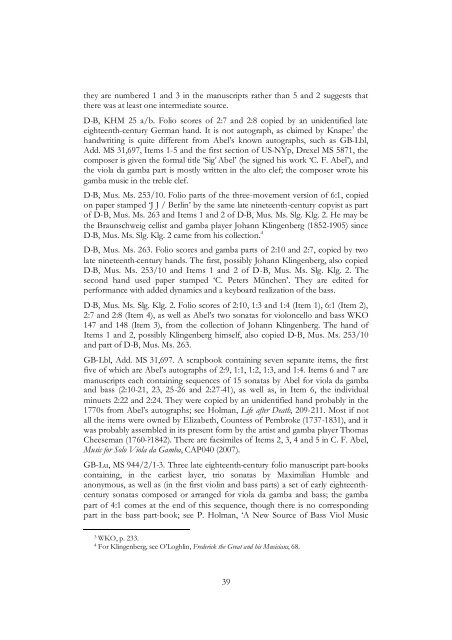Partiturbuch Ludwig - The Viola da Gamba Society
Partiturbuch Ludwig - The Viola da Gamba Society
Partiturbuch Ludwig - The Viola da Gamba Society
Create successful ePaper yourself
Turn your PDF publications into a flip-book with our unique Google optimized e-Paper software.
they are numbered 1 and 3 in the manuscripts rather than 5 and 2 suggests that<br />
there was at least one intermediate source.<br />
D-B, KHM 25 a/b. Folio scores of 2:7 and 2:8 copied by an unidentified late<br />
eighteenth-century German hand. It is not autograph, as claimed by Knape: 3 the<br />
handwriting is quite different from Abel’s known autographs, such as GB-Lbl,<br />
Add. MS 31,697, Items 1-5 and the first section of US-NYp, Drexel MS 5871, the<br />
composer is given the formal title ‘Sig r Abel’ (he signed his work ‘C. F. Abel’), and<br />
the viola <strong>da</strong> gamba part is mostly written in the alto clef; the composer wrote his<br />
gamba music in the treble clef.<br />
D-B, Mus. Ms. 253/10. Folio parts of the three-movement version of 6:1, copied<br />
on paper stamped ‘J J / Berlin’ by the same late nineteenth-century copyist as part<br />
of D-B, Mus. Ms. 263 and Items 1 and 2 of D-B, Mus. Ms. Slg. Klg. 2. He may be<br />
the Braunschweig cellist and gamba player Johann Klingenberg (1852-1905) since<br />
D-B, Mus. Ms. Slg. Klg. 2 came from his collection. 4<br />
D-B, Mus. Ms. 263. Folio scores and gamba parts of 2:10 and 2:7, copied by two<br />
late nineteenth-century hands. <strong>The</strong> first, possibly Johann Klingenberg, also copied<br />
D-B, Mus. Ms. 253/10 and Items 1 and 2 of D-B, Mus. Ms. Slg. Klg. 2. <strong>The</strong><br />
second hand used paper stamped ‘C. Peters München’. <strong>The</strong>y are edited for<br />
performance with added dynamics and a keyboard realization of the bass.<br />
D-B, Mus. Ms. Slg. Klg. 2. Folio scores of 2:10, 1:3 and 1:4 (Item 1), 6:1 (Item 2),<br />
2:7 and 2:8 (Item 4), as well as Abel’s two sonatas for violoncello and bass WKO<br />
147 and 148 (Item 3), from the collection of Johann Klingenberg. <strong>The</strong> hand of<br />
Items 1 and 2, possibly Klingenberg himself, also copied D-B, Mus. Ms. 253/10<br />
and part of D-B, Mus. Ms. 263.<br />
GB-Lbl, Add. MS 31,697. A scrapbook containing seven separate items, the first<br />
five of which are Abel’s autographs of 2:9, 1:1, 1:2, 1:3, and 1:4. Items 6 and 7 are<br />
manuscripts each containing sequences of 15 sonatas by Abel for viola <strong>da</strong> gamba<br />
and bass (2:10-21, 23, 25-26 and 2:27-41), as well as, in Item 6, the individual<br />
minuets 2:22 and 2:24. <strong>The</strong>y were copied by an unidentified hand probably in the<br />
1770s from Abel’s autographs; see Holman, Life after Death, 209-211. Most if not<br />
all the items were owned by Elizabeth, Countess of Pembroke (1737-1831), and it<br />
was probably assembled in its present form by the artist and gamba player Thomas<br />
Cheeseman (1760-?1842). <strong>The</strong>re are facsimiles of Items 2, 3, 4 and 5 in C. F. Abel,<br />
Music for Solo <strong>Viola</strong> <strong>da</strong> <strong>Gamba</strong>, CAP040 (2007).<br />
GB-Lu, MS 944/2/1-3. Three late eighteenth-century folio manuscript part-books<br />
containing, in the earliest layer, trio sonatas by Maximilian Humble and<br />
anonymous, as well as (in the first violin and bass parts) a set of early eighteenthcentury<br />
sonatas composed or arranged for viola <strong>da</strong> gamba and bass; the gamba<br />
part of 4:1 comes at the end of this sequence, though there is no corresponding<br />
part in the bass part-book; see P. Holman, ‘A New Source of Bass Viol Music<br />
3 WKO, p. 233.<br />
4 For Klingenberg, see O’Loghlin, Frederick the Great and his Musicians, 68.<br />
39

















